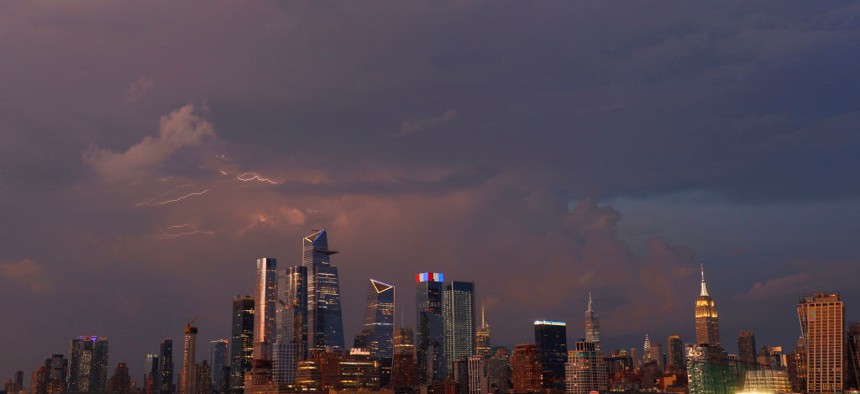Op-ed: Amid affordable housing and homelessness crises, NYC invests in luxury developments that stay vacant
It’s time to curb these development projects by doing away with tax incentives like 421-a and section 581 of the New York State Real Property Tax Law.

Gary Hershorn / Contributor
A recent report by real estate company Douglas Elliman found that median rental prices in Manhattan, Brooklyn, and Queens have risen above pre-pandemic levels, and in many areas rents are setting price records or near-records. A study using 2017 Census Housing and Vacancy Survey data found that 42% of New York City renters pay more than 30% of their pre-tax income on rent, classifying them as “rent burdened.” And according to the Coalition for The Homeless, a near-record number of 48,482 homeless people a day, including 15,045 homeless children, slept in city shelters in February 2022.
Clearly, New York is facing dual interconnected crises around affordability and homelessness. More housing is needed, and this housing has to be affordable. However, recent major construction in the city has been dominated by massive luxury condominium developments.
The units in these developments – like in Hudson Yards or “Billionaires’ Row” luxury towers along 57th Street – feature troubling rates of residential vacancy. Part of what is producing these vacancy rates is a simple lack of demand for this form of luxury unit, resulting in large numbers of unsold units. According to an analysis by brokerage firm Serhant, 44% of condo units in Billionaire’s row had not been sold by August of 2021.
Another driver of these vacancy rates are condominiums that are owned by foreign or out-of-state investors with few local ties and are rarely occupied. Scholars Jae-Yong Chung and Kevin Carpenter at The Hongik University coined the term “safe havens” to describe major cities like London, New York, and Melbourne that incentivized foreign investment in luxury real estate markets following the 2008 financial crisis, and are now experiencing high rates of vacancy in these luxury markets, applying downwards supply pressure and a strain on affordability on the apartment market as a whole.
Take Hudson Yards example. The $25 billion development received $6 billion in government funding from a mix of state-level subsidies and the controversial EB-5 visa program. The development hoped to bring luxury retailers and condos to the far upper west side. While multiple phases of construction have been successfully completed, hundreds of condo and office units remain unsold, and the development group has scrapped the initial 2024 completion date for the final phase of the project. Hudson Yards stands as a gilded ghost town, a monument to a foolish model of private-public partnership in housing. Ironically, the development’s signature public art piece, The Vessel, has remained temporarily closed to visitors since January following a string of suicides.
The city has some options for where to go from here. First, lawmakers in Albany should follow through with eliminating the 421a tax abatement program – which is set to expire in July – that awards tax incentives to new developments. New York City Comptroller Brad Lander released a report on 421-a that called the program “expensive and inefficient” and called for it to be allowed to expire. Further, section 581 of the New York State Real Property Tax Law should be revised or done away with. Section 581 requires condo and co-op units to be appraised as if they were rental properties. A report by New York City Advisory Commission on Property Tax Reform found that this practice results in condos and co-ops being consistently undervalued, resulting in a significant loss of tax revenue via tax breaks to condo developers. Eliminating 421-a and 581 from the tax code would reduce the scale of public funds going to these excessive luxury development projects.
In addition, cities like Paris and Vancouver have implemented ‘vacancy taxes’, which impose a tax on units that remain vacant for a portion (typically six or nine months) of the year. In Vancouver, this tax is 1% of the property’s value, but in Paris, the tax is 60%. These taxes have caused issues and complications during implementation, but cities have seen benefits like reducing vacancy, curbing speculation, and raising funds for the municipality. New York legislators should learn from the vacancy tax programs in Vancouver and Paris, and consider this form of tax.
Ultimately, curbing publicly subsidized luxury developments and reducing luxury vacancy should be a priority for the City Council, the Mayor’s office, and lawmakers in Albany. Addressing the issue of empty luxury apartments is a necessity in a city that struggles with housing affordability and high rates of homelessness. Eliminating these vacancies would change the purpose of housing development in New York to create space for people to live in, not for the extremely wealthy to park their wealth.
